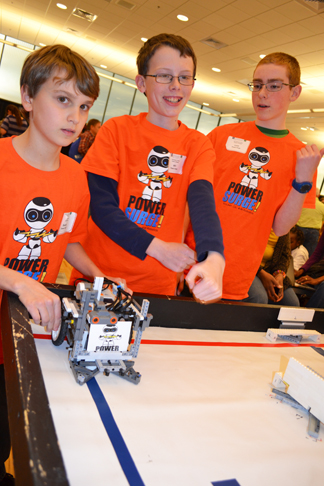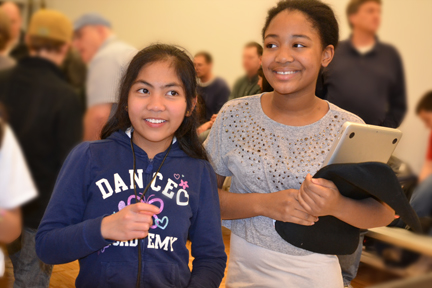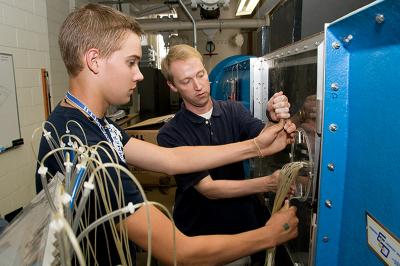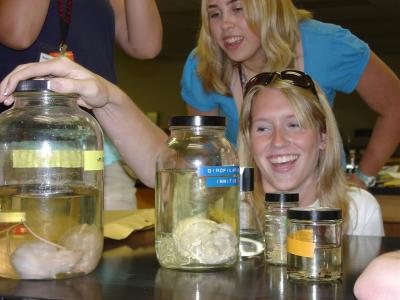4-H Exposes Youth to STEM Via Informal Education

Youngster proudly displays the robot she helped build for the 4-H Robotics competition.
May 7, 2013
Fifty years ago, 4-H used to be synonymous with youngsters competing to see who could raise the largest pig or bake the tastiest pie for the county fair. No longer your father's 4-H (or your mother's), some of the youth-development organization's clubs today are devoted entirely to STEM (science, technology, engineering, and mathematics) and have 20th Century topics, such as geospacial technology, video film-making, computer science, wind power, and even robotics.
4-H is the flagship youth development program of the Cooperative Extension Network administered by over 100 land-grant universities across the country, including the University of Illinois at Urbana-Champaign. According to Lisa Boullion Diaz, Science Specialist for the Illinois 4-H, 4-H programming offers out-of-school, nonformal education opportunities kids can self-select. In addition to traditional, community-based programs, 4-H now offers SPIN (Special Interest) clubs on any topic and for a shorter time period. 4-H currently involves at least 7 million youth nationally, with 200,000 of those in the state of Illinois. Diaz describes characteristics common to all 4-H programs:
"Young people who are joining 4-H can expect to have a hands-on learning experience, to have opportunities to really personalize their learning, and to explore interests in a wide range of program areas."
And according to Diaz, kids find the opportunity to learn new and interesting things through 4-H to be addicting: "It's very common for a young person to get hooked into 4-H based on one interest (that might be robotics), and then they get our Clover, which is the annual catalog that we put out for members, and they start flipping through and they see that we have theater arts, and environmental science, and leadership skill, and civic engagement, and cooking, and all the other stuff." Including STEM.
Diaz says that the original science focus of the more than 100-year-old program was largely agriculture and animal science. But as technology has changed, 4-H has changed with it, expanding its science-and-technology-related programs to keep up, including an initiative begun in 2005 emphasizing STEM education.

Members of the PowerSurge robotics team prepare to compete.
A popular STEM emphasis is robotics. For example, 4-H now has at least 41 robotics teams, where students build robots from kits like Lego Mindstorm, including writing the computer programming to operate them. Many of these teams are involved in competitions, such as 4-H's annual robotics competition, which was just held on the Illinois campus in April 2013. 4-H robotics teams also participate in FIRST robotics competitions. In fact, 4-H and FIRST have a national partnership, which Diaz calls a "win-win."
"4-H and FIRST is a beautiful marriage," explains Diaz. "Because FIRST understands competition and knows how to involve high-profile partners and supporters of robotics that can really spark excitement in those competition events. 4-H really gets on-going, sustained youth development and learning that is supported with these local mentors, caring adults, and peer learning groups. And when you put those two together around any subject area, like robotics, we've just seen things grow like wildfire."
Another STEM curriculum, "Going Places, Exploring Spaces," which addresses geoscience, teaches kids about navigating with different geographic tools. Beginning with a historical overview of navigation (compasses, star navigation), it advances to more modern tools (street maps), and finally introduces kids to the latest technology: GIS (Geographic Information Systems) and GPS (Geographic Positioning System) and includes some hands-on geocaching projects they can do in their own communities.

Two contestants enjoying the 4-H robotics competition.
Along with after-school programs and weekend camps, 4-H also provides a number of summer activities, such as summer camps and the 4-H Illini Summer Academies (ISA).
ISA is a 4-day event, which gives teens the opportunity to explore both potential careers and the campus, experience campus life by staying in university dorms, plus build their leadership skills and meet other youth from around the state. The 2013 ISA, scheduled for June 23–26, partners with a number of campus units to provide 15 hours of classroom/lab activities, including hands-on opportunities for participants in the following disciplines, many of which are STEM-related:
- Aerospace Engineering
- Art & Design
- Creative Writing
- Crop Science
- Electrical & Computer Engineering
- Landscape Architecture
- Leadership Academy
- Molecular & Cellular Biology
- Natural Resources & Environmental Sciences
- Veterinary Medicine

ISA participant experiences the wind lab as a part of the Aerospace Engineering Academy. (Photo courtesy Illinois 4-H Photo Galleries.)
Along with the chance to explore the above career-related learning opportunities, participants can attend social events with other teens, including a dance.
While Diaz' Ph.D. was in Learning Sciences, which blends computer science with cognitive science and learning—in other words, using technology to teach—her career over last 20 years has involved in-school and out-of-school science programs, perfectly positioning her for her current role in 4-H:
"Science and technology is all around us, and I am especially passionate about helping young people see that relevance and connectedness of science and technology in their everyday lives today, as well as in their future lives as adults. So my hope is that each kid will see that relevance, be interested in learning more, and develop at least some of those fundamental understandings and skills that will help them be informed citizens and to participate in a diversifying workplace."
And along with helping youngsters understand how STEM relates to their everyday lives, Diaz hopes to steer some of them into STEM careers: "I also hope that some of those kids will see future career opportunities in fields of science and technology that they otherwise may not have seen."
Story and photos by Elizabeth Innes, Communications Specialist, I-STEM Education Initiative
More: 4-H, FIRST, K-12 Outreach, 2013
For more information about 4-H STEM programming, see this additional I-STEM webarticle: 4-H Robotics: Working to Make a STEM Career Down the Line Automatic.














.jpg)
















